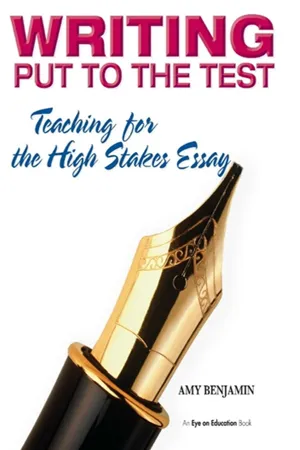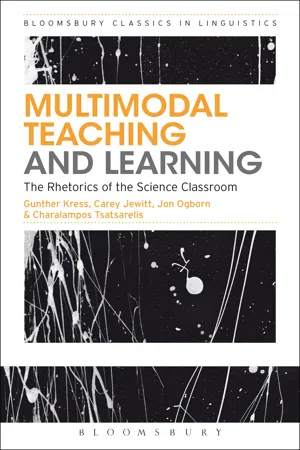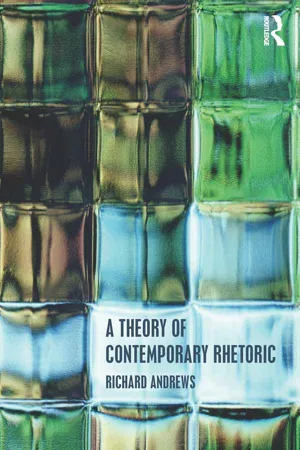Languages & Linguistics
Description Rhetorical mode
Description is a rhetorical mode that involves creating a vivid picture of a person, place, thing, or event through the use of sensory details. It aims to provide a clear and accurate representation of the subject being described, allowing the reader to visualize it in their mind. Description is commonly used in literature, journalism, and advertising.
Written by Perlego with AI-assistance
Related key terms
Related key terms
1 of 4
Related key terms
1 of 3
3 Key excerpts on "Description Rhetorical mode"
- eBook - ePub
Writing Put to the Test
Teaching for the High Stakes Essay
- Amy Benjamin(Author)
- 2013(Publication Date)
- Routledge(Publisher)
IIRhetorical Modes
Passage contains an image
5
Teaching Writing Through Rhetorical Modes
Because much of our understanding of the world comes through the recognition of patterns, it is extremely helpful to understand how writing topics fall into the following major rhetorical modes: ♦ Narration ♦ Description ♦ Cause and effect ♦ Classification and division ♦ Comparison/contrast It should be noted that some writing texts condense these categories onto only four rhetorical modes: narration, description, exposition, and persuasion.Each rhetorical mode accomplishes its own purpose. Each comes with its own structure and language. Most text is organized around a predominant rhetorical mode, supported by at least one secondary mode. For example, narration often partners up with description; definition partners with exemplification.Teaching writing through the rhetorical modes, which are also called discourse modes, goes way back to Aristotle. However, this paradigm for teaching writing lost its place at the table of writing instruction in the 1970s and 1980s when “process pedagogy” came into favor. Actually, there’s no reason why instruction in the rhetorical modes needs to compete with writing process instruction: both can be mutually supportive. The advantage of teaching writing through the rhetorical modes, as we will see, is that once we know what mode we’re in, we can build within an existing structure that we already understand.Karen Gocsik, executive director of the writing program at Dartmouth College, says this about discourse mode pedagogy:[M]odes of discourse instruction can be used to lead students systematically through a hierarchical system of cognitive functions. In these classrooms, professors develop assignments that progress through the modes, moving students from the personal narrative to the analytical argument, and from simple organizational strategies that are chronological and spatial, to more complex organizational strategies that are more formally logical. In this way, modes of discourse instruction sharpen students’ critical and analytical skills. - eBook - ePub
Multimodal Teaching and Learning
The Rhetorics of the Science Classroom
- Gunther Kress, Carey Jewitt, Jon Ogborn, Tsatsarelis Charalampos(Authors)
- 2014(Publication Date)
- Bloomsbury Academic(Publisher)
stars) Reconstituting students’ identity (e.g. learner, expert, young scientist) Rhetorical orchestration of meaning The analysis in terms of rhetorical frames was applied to lessons to produce a map of the shifts in rhetoric across the lesson and series of lessons so as to reveal their rhetorical architecture. Mapping the rhetorical frames in this way enabled us (i) to describe instances of how rhetoric is constructed during a lesson and series of lessons and show the cumulative effect of rhetorical framing; and (ii) to explore how teachers and students differ in their organization of rhetorical frames, that is, in the rhetorical architectures of different classrooms, and how these realize different (rhetorical) meanings and effects. As well as giving attention to how each mode makes meaning by itself, our aim was to identify the ways in which different modes of communication contribute to the rhetorical orchestration of meaning in the science classroom. We wish to be able to describe how teachers use image, action, manipulation of objects, speech, and so on to construct the entities of the science classroom, and how they realize other rhetorical functions in science lessons. From our analysis it is clear that each mode plays a distinct and different role in the realization of these rhetorical functions (as in our example of the visualization of the entity ‘blood’). All the modes are jointly orchestrated across a lesson and across a series of lessons in order to build up meaning over time. In this way, we see meaning as emerging from a process of interaction, contrast and conjunction of the modes - eBook - ePub
- Richard Andrews(Author)
- 2013(Publication Date)
- Routledge(Publisher)
3Rhetoric and English StudiesAs has been suggested so far, rhetoric is the discipline that has been the basis for theorizing about communication in public since pre-Athenian days—not the pejorative use of the term in phrases such as “mere rhetoric” or “cant, sophistication, and rhetoric.” The knife-edge nature of the term makes use of it risky. Nevertheless, the risk is worth taking in relation to the future of English as a school and university subject.Rhetoric is about who communicates what to whom about what, in which modes and media, how and (sometimes) why—though the latter function encroaches into the territory of philosophy. It can variously be described as “the arts of discourse” or “the science of communication.” One of its great advantages is that it does not limit itself to any particular language—English, Mandarin, Spanish—nor to any particular mode— writing, for example—or medium (e.g., on screen, on paper). It includes other modes, such as the still image, moving image, gesture, and sound, as well as the verbal mode, which covers speech and writing. It is not only socially situated but politically situated, too, sensitive to the power relations that inform communication between individuals and between groups, on domestic, local, regional, national, and international levels. (The rhetoric of communication beyond the planet has been wittily dealt with in Edwin Morgan's poetry collection, From Glasgow to Saturn , 1973.) It is pan- or multi-linguistic, multimodal, and socio/political and thus—potentially—provides a unifying theory for “English” and other subjects concerned with communication.“English” seems to be a misnomer. We might be engaged with writing in English from across the world, but we should also acknowledge that such writing may have been cast originally in another language and/or culture—and so issues of translation are at play. We are interested in the evolving history of the English language, in all its hybrid color, but we will be also interested, as a result, in world Englishes and how they are being owned and developed in the twenty-first century. And by “English” we will certainly be interested in fictional, dramatic, and lyrical genres, but also in real-world documentaries, manuals, reports, spoken genres, and other transactional forms of language that go under the broad and strangely negative title of “non-fiction.” We will not
Index pages curate the most relevant extracts from our library of academic textbooks. They’ve been created using an in-house natural language model (NLM), each adding context and meaning to key research topics.
Explore more topic indexes
Explore more topic indexes
1 of 6
Explore more topic indexes
1 of 4


